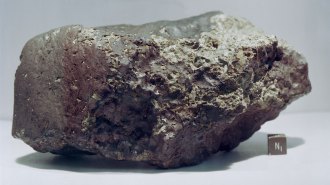Search Results
Studying the brain 101
Students will be introduced to neuroscience by learning about nerve anatomy and physiology, and they will research different methods of studying the brain.
Learning Outcomes: Develop an understanding of how scientists approach the study of the brain.
CRISPR Explained
Students will learn how CRISPR gene-editing technology works and discuss its applications and its importance to research.
Learning Outcomes: Learning about CRISPR and why it is an important technology
Prairie voles can couple up even without the ‘love hormone
Students will answer questions about the online Science News article “Prairie voles can find partners just fine without the ‘love hormone’ oxytocin,” which explores how scientists upended a common understanding of the hormone by using CRISPR technology. A version of the article “Voles don’t need oxytocin to bond” appears in the February 25, 2023 issue of Science News.
Making sense of animal worlds
In this activity, students will discuss how literary devices can be used to convey scientific concepts, research how an animal of their choice senses the world and compose a piece of creative writing based on what they find.

Deep-sea ‘Octomoms’ Seek the Heat
In this guide, students will answer questions about how scientists discovered that octopuses laying eggs in warm waters near geothermal springs are speeding up hatching. Students will then define rates and their units of measurement for biological and chemical processes and discuss factors that affect rates.
Rates and what affects them
Students will define rates and their units of measurement for biological and chemical processes before discussing factors that affect rates.
Octopus moms seek the heat
Students will answer questions about the Science News article “Some deep-sea octopuses aren’t the long-haul moms scientists thought they were,” which describes how octopuses laying eggs in warm waters near geothermal springs speed up hatching. A version of the article, “Deep-sea ‘octomoms’ seek the heat,” appears in the April 9, 2022 issue of Science News.

The Age of Dinosaurs May Have Ended in Springtime
In this guide, students will answer claim, evidence and reasoning questions about how scientists used the bones of ancient fish to determine during what season an asteroid wiped out nonavian dinosaurs. They will then explore the physical properties of human bones and how bones offer evidence to support scientific claims.
Dig into bones
Students will discuss the physical properties of human bones and how bones can offer evidence to support scientific claims. Then students can search Science News for examples of how bones have been used as evidence.

Meteorite’s Organics Aren’t Signs of Life
In this guide, students will learn about the origin of organic material found inside a meteorite from Mars and discuss how new evidence can be used to reevaluate scientific claims.
Evaluating scientific claims with new evidence
Students will compare two Science News articles and analyze how new evidence has revised an initial claim and the reasoning behind that claim. As a bonus, students can answer chemistry questions about abiotic and biotic reactions.

Chemistry that’s out of this world
Students will answer questions about the online Science News article “Organic molecules in an ancient Mars meteorite formed via geology, not alien life,” which describes new research into the origin of organic material found in a space rock. A version of the article, “Meteorite’s organics aren’t signs of life,” appears in the February 12, 2022 issue of Science News.